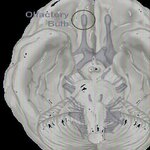Neuroscience

Driving to work is routine, you might even forget you are doing it, but how aware would you be if you had to doit in reverse?
We're used to seeing objects pass behind us as we go forward. Moving backwards feels unnatural and a new study finds why that is: Moving forward actually trains the brain to perceive the world normally. The relationship between neurons in the eye and the brain is more complicated than previously thought--in fact, the order in which we see things could help the brain calibrate how we perceive time, as well as the objects around us.
Reversing the Map
The new study began…

As baby boomers, originally the children born in 1946, after soldiers returned home from World War II in 1945 but later extended out to be an entire generation, move into old age, the financial burden of Alzheimer's disease in the United States will skyrocket to $1.5 trillion from current from $307 billion
estimates, according to health policy scholars at the USC Leonard D. Schaeffer Center for Health Policy and Economics.
According to the U.S. Census Bureau, in 2012, 43.1 million Americans were 65 and older, constituting 14 percent of the population. By 2050, that number will more than…

Though marijuana use has gone up sharply since 2007, claims about its lack of harm compared to cigarettes or drugs are not based on evidence. Instead, studies have shown abnormalities in brain function and structure of long-term marijuana users and that chronic marijuana users have smaller brain volume in the orbitofrontal cortex (OFC), a part of the brain commonly associated with addiction, but also increased brain connectivity.
But the effects of chronic marijuana use on the brain may depend on the age of first use and duration of use, according to researchers.
In…

Patients with Amyotrophic lateral sclerosis (ALS), commonly known as Lou Gehrig's Disease, have difficulty with action verbs: Why action verbs and not regular verbs or nouns?
According to some papers, the fact that ALS patients experience it isn't the actual severe motor deficits of the disease, the greater linguistic difficulty with verbs denoting action compared to nouns depends on the motor deficit.
The motor system plays a role in the semantic encoding of action verbs? Real or spurious correlations? A new tested this hypothesis and their conclusion suggests a major role for the “…

An experiment with 42 people under functional magnetic resonance imaging (fMRI) found that if people see pictures of others being loved and cared for, it subsequently reduces
the brain's threat monitor, the amygdala,
response to threats.
This occurred even if the person was not paying attention to the content of the first pictures.
The study in Social, Cognitive and Affective Neuroscience, suggests that being reminded of being loved and cared for dampens the threat response and may allow more effective functioning during, and activation of soothing resources after, stressful…

vivaviena, CC BY-NC-SA
By Vincent F Hendricks, University of Copenhagen
Science, like any other field that attracts investment, is prone to bubbles.
Overly optimistic investments in scientific fields, research methods and technologies generate episodes comparable to those experienced by financial markets prior to crashing.
Assessing the toxic intellectual debt that builds up when too much liquidity is concentrated on too few assets is an important task if research funders want to avoid going short on overvalued research.
The cause of the meltdown of the financial market is obvious: leveraged…

Our brains make judgments about images before we're even aware of making a decision. A Health Blog/Flickr, CC BY-NC
By Daniel Bennett, University of Melbourne
What makes us decide? At one level, this seems like an easy question: we think our options through, pick the one we like best and act on it.
If we dig a little deeper, though, the question becomes more difficult to answer. How do we settle on what our options are? What makes us prefer one option to another?
These decisions may be partially unconscious, according to mounting evidence. This is because, from moment to moment, our brains…

When it comes to our senses, there is a lot of diversity in people. One person might have 10X the taste buds on their tongue as another person, for example, so they are more sensitive to bitters and sweets. But is there a quantifiable gender difference in the ability to hear or taste?
A new paper says women smell better than men - not as in their odor, but in their ability to detect and evaluate odors. If so, they postulate that sex differences in olfactory detection may play a role in differentiated social behaviors and may be connected to one's perception of smell, which is naturally…

In what they are terming the largest MRI study to date, a group of researchers writing in Cerebral Cortex have found that the brain anatomy in MRI scans of people with autism above age six is mostly indistinguishable from that of typically developing individuals and, therefore, of little clinical or scientific value.
The researchers used data from the Autism Brain Imaging Data Exchange (ABIDE), which provides an unprecedented opportunity to conduct large-scale comparisons of anatomical MRI scans across autism and control groups and resolve many outstanding questions.
This recently-…

Children and adults alike are digging out those spooky costumes ready for a celebration.
We’ve reached that time of year again: Halloween. October 31 is dedicated to remembering the dead.
We’ve all experienced fear, but Halloween is the particular time of year when we look for that rush that usually accompanies feeling scared. Are you in need of a “scare-specialist” for this year’s Halloween celebrations? Then you need not look further than your very own brain.
Perhaps you’ll be spending Halloween watching A Nightmare on Elm Street with your hands over your eyes? Or maybe you’d rather…